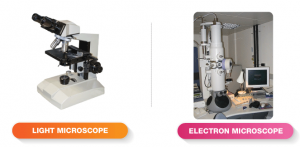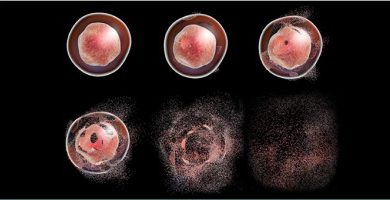There are two common types of microscopes i.e. light microscope and electron microscope. Both use radiation to form detailed images of objects that a human eye cannot produce unaided. The basic differences between light microscopes and electron microscopes are that light microscopes are lighter and smaller so are easy to move and set up and an image is formed by the absorption of light waves.
These images are viewed by the eyes through the eyepiece. on the other hand, an electron microscope is big and heavy, and they are hard to move and set up and the image is formed by scattering or transmission of electrons.
These images are viewed on a photographic plate or zinc sulfate fluorescent screen in this microscope. Nowadays, electron microscopes are widely used by scientists in laboratories for the detailed study of organisms whereas light microscopes are used by schools and colleges for viewing organisms that are easily visible through them.

Differences Between Light Microscope and Electron Microscope in Tabular Form:
| Light Microscope | Electron Microscope |
| These microscopes are lighter and smaller and use light beams (approx. 400-700 nm) as an illuminating source. | These microscopes are big and heavy and use electron beams (1 nm) as an illuminating source. |
| These microscopes are easy to move and set up. | These microscopes are hard to move and set up. |
| They have magnification power up to 1,500x. | They have magnification power up to 1,000,000x. |
| Light microscopes have low resolution. | Electron microscopes have high resolution. |
| The light microscope is inexpensive and requires a low maintenance cost. | The electron microscope is expensive and requires high maintenance. |
| These are easy to use, cheap, true-color, and live specimens. | These have high resolution, provide detailed images of interior structures, have high magnification power, and create 3D images. |
| In these microscopes, lenses are made of glasses, and no need for high voltage electricity | Lenses are made up of electromagnets A high voltage electric current is required (50,000 V) |
Light Microscope
A light microscope uses visible light to detect and magnify very small objects and enlarging them. It uses lenses to focus light on the specimen, magnifying it thus producing an image. The specimen is normally placed close to the microscopic lens.
Principle
A light microscope is based on its ability to focus a beam of light through a specimen, which is very small and transparent, to produce an image. The image is then passed through one or two lenses for magnification for viewing. The transparency of the specimen allows easy and quick penetration of light. Specimens can vary from bacterial to cells and other microbial particles.
Uses
A light microscope is used for the study of detailed gross internal structure and is vastly used in microbiology.
Electron Microscope
An electron microscope uses a beam of accelerated electrons as a source of illumination. It has a high resolution of images, able to magnify objects in nanometres, which are formed by the controlled use of electrons in a vacuum captured on a phosphorescent screen. It uses signals arising from the interaction of an electron beam with the sample to obtain information about structure, morphology, and composition.
Principle
The image is formed by scattering or transmission of electrons in these microscopes. Focusing is done by adjusting the power of the electric current to the electromagnetic lenses then images are viewed on a photographic plate or zinc sulfate fluorescent screen.
Read Also: Light Microscope Vs. Electron Microscope
Uses
These are used to investigate the ultrastructure of a wide range of biological and inorganic specimens including microorganisms, cells, large molecules, biopsy samples, metals, and crystals.
You May Also Read:


